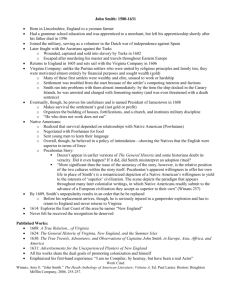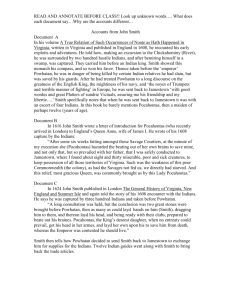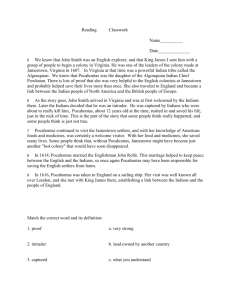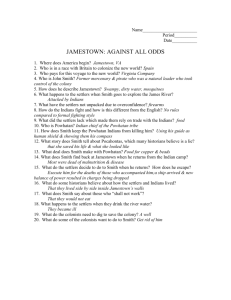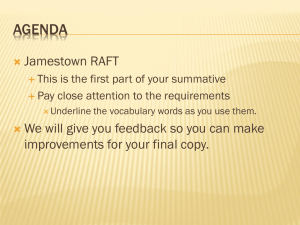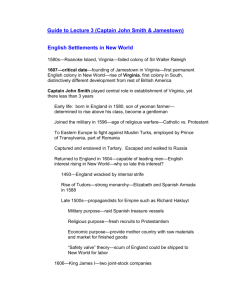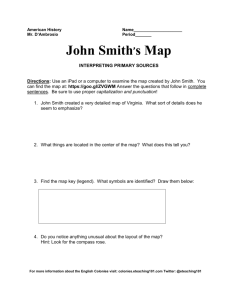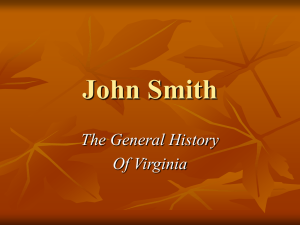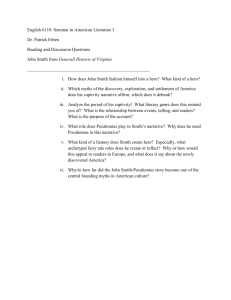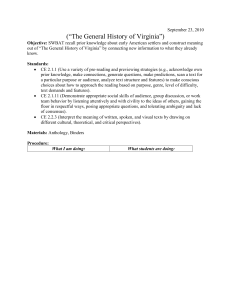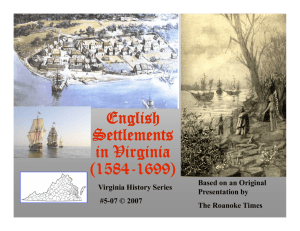Captain John Smith 1580-1631
advertisement
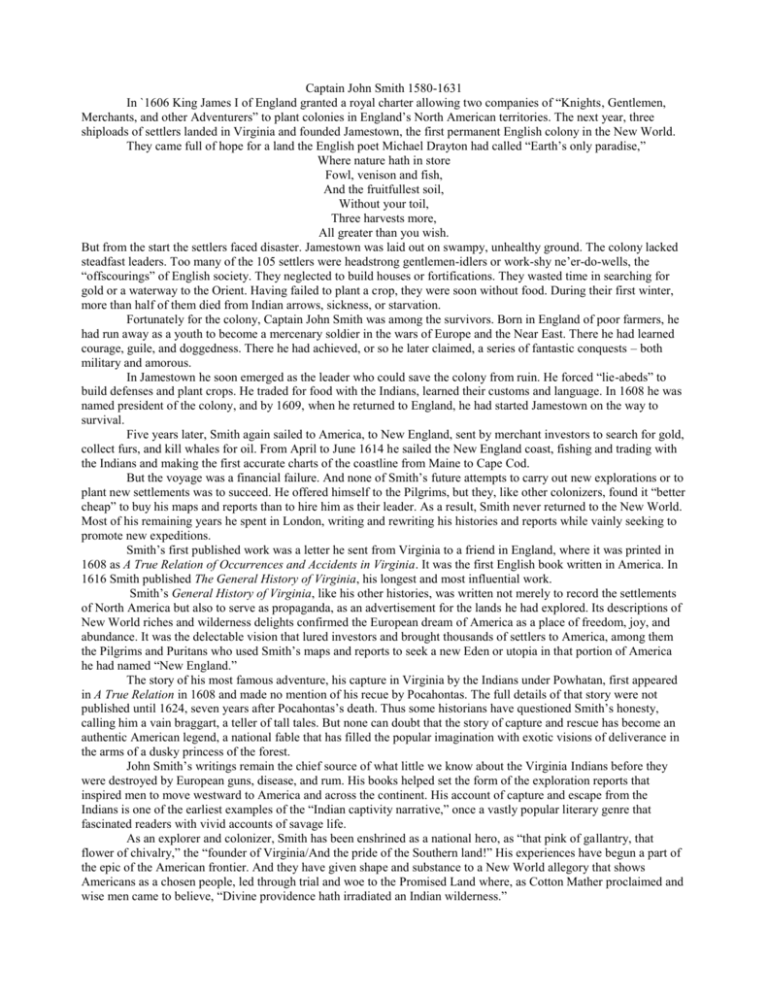
Captain John Smith 1580-1631 In `1606 King James I of England granted a royal charter allowing two companies of “Knights, Gentlemen, Merchants, and other Adventurers” to plant colonies in England’s North American territories. The next year, three shiploads of settlers landed in Virginia and founded Jamestown, the first permanent English colony in the New World. They came full of hope for a land the English poet Michael Drayton had called “Earth’s only paradise,” Where nature hath in store Fowl, venison and fish, And the fruitfullest soil, Without your toil, Three harvests more, All greater than you wish. But from the start the settlers faced disaster. Jamestown was laid out on swampy, unhealthy ground. The colony lacked steadfast leaders. Too many of the 105 settlers were headstrong gentlemen-idlers or work-shy ne’er-do-wells, the “offscourings” of English society. They neglected to build houses or fortifications. They wasted time in searching for gold or a waterway to the Orient. Having failed to plant a crop, they were soon without food. During their first winter, more than half of them died from Indian arrows, sickness, or starvation. Fortunately for the colony, Captain John Smith was among the survivors. Born in England of poor farmers, he had run away as a youth to become a mercenary soldier in the wars of Europe and the Near East. There he had learned courage, guile, and doggedness. There he had achieved, or so he later claimed, a series of fantastic conquests – both military and amorous. In Jamestown he soon emerged as the leader who could save the colony from ruin. He forced “lie-abeds” to build defenses and plant crops. He traded for food with the Indians, learned their customs and language. In 1608 he was named president of the colony, and by 1609, when he returned to England, he had started Jamestown on the way to survival. Five years later, Smith again sailed to America, to New England, sent by merchant investors to search for gold, collect furs, and kill whales for oil. From April to June 1614 he sailed the New England coast, fishing and trading with the Indians and making the first accurate charts of the coastline from Maine to Cape Cod. But the voyage was a financial failure. And none of Smith’s future attempts to carry out new explorations or to plant new settlements was to succeed. He offered himself to the Pilgrims, but they, like other colonizers, found it “better cheap” to buy his maps and reports than to hire him as their leader. As a result, Smith never returned to the New World. Most of his remaining years he spent in London, writing and rewriting his histories and reports while vainly seeking to promote new expeditions. Smith’s first published work was a letter he sent from Virginia to a friend in England, where it was printed in 1608 as A True Relation of Occurrences and Accidents in Virginia. It was the first English book written in America. In 1616 Smith published The General History of Virginia, his longest and most influential work. Smith’s General History of Virginia, like his other histories, was written not merely to record the settlements of North America but also to serve as propaganda, as an advertisement for the lands he had explored. Its descriptions of New World riches and wilderness delights confirmed the European dream of America as a place of freedom, joy, and abundance. It was the delectable vision that lured investors and brought thousands of settlers to America, among them the Pilgrims and Puritans who used Smith’s maps and reports to seek a new Eden or utopia in that portion of America he had named “New England.” The story of his most famous adventure, his capture in Virginia by the Indians under Powhatan, first appeared in A True Relation in 1608 and made no mention of his recue by Pocahontas. The full details of that story were not published until 1624, seven years after Pocahontas’s death. Thus some historians have questioned Smith’s honesty, calling him a vain braggart, a teller of tall tales. But none can doubt that the story of capture and rescue has become an authentic American legend, a national fable that has filled the popular imagination with exotic visions of deliverance in the arms of a dusky princess of the forest. John Smith’s writings remain the chief source of what little we know about the Virginia Indians before they were destroyed by European guns, disease, and rum. His books helped set the form of the exploration reports that inspired men to move westward to America and across the continent. His account of capture and escape from the Indians is one of the earliest examples of the “Indian captivity narrative,” once a vastly popular literary genre that fascinated readers with vivid accounts of savage life. As an explorer and colonizer, Smith has been enshrined as a national hero, as “that pink of gallantry, that flower of chivalry,” the “founder of Virginia/And the pride of the Southern land!” His experiences have begun a part of the epic of the American frontier. And they have given shape and substance to a New World allegory that shows Americans as a chosen people, led through trial and woe to the Promised Land where, as Cotton Mather proclaimed and wise men came to believe, “Divine providence hath irradiated an Indian wilderness.”
